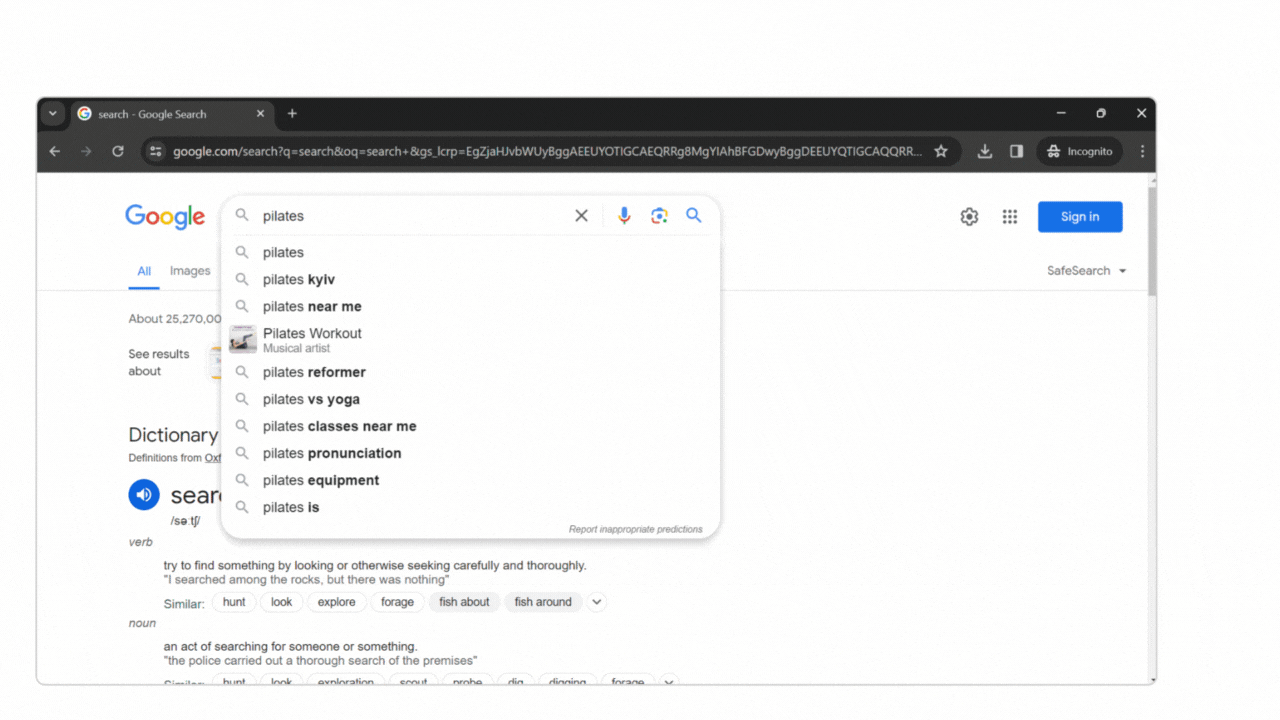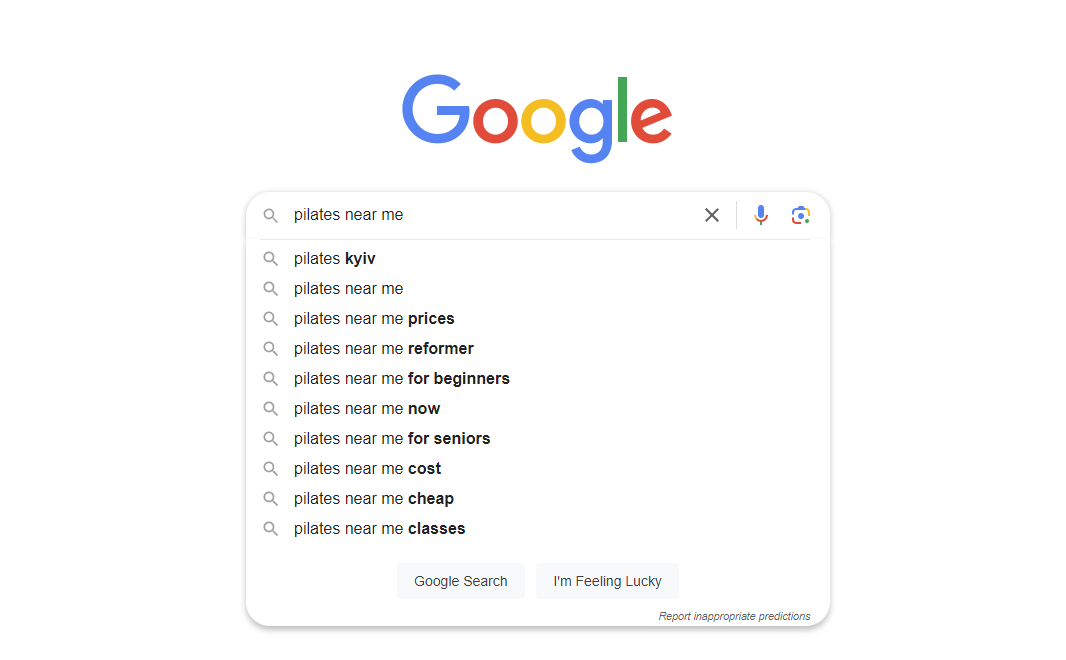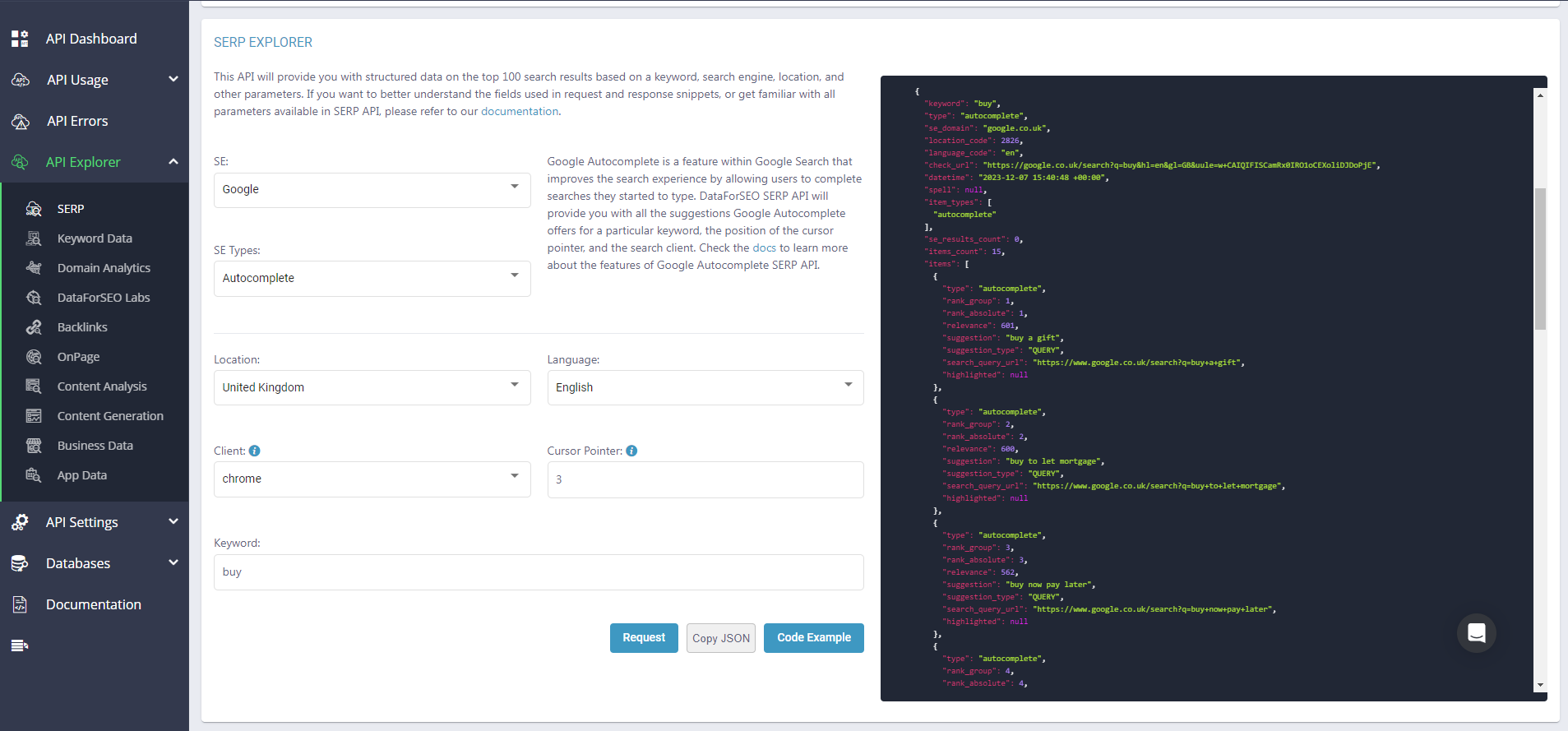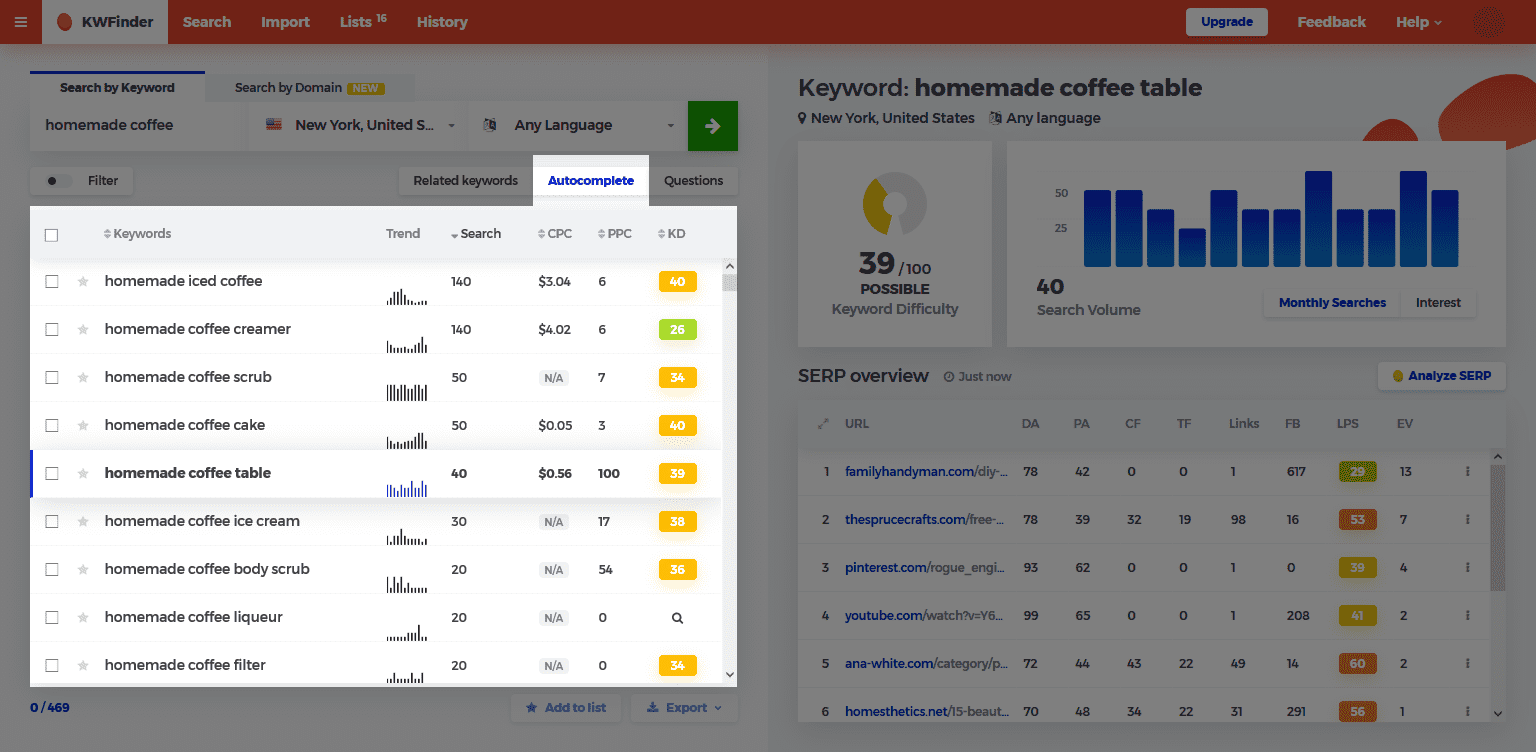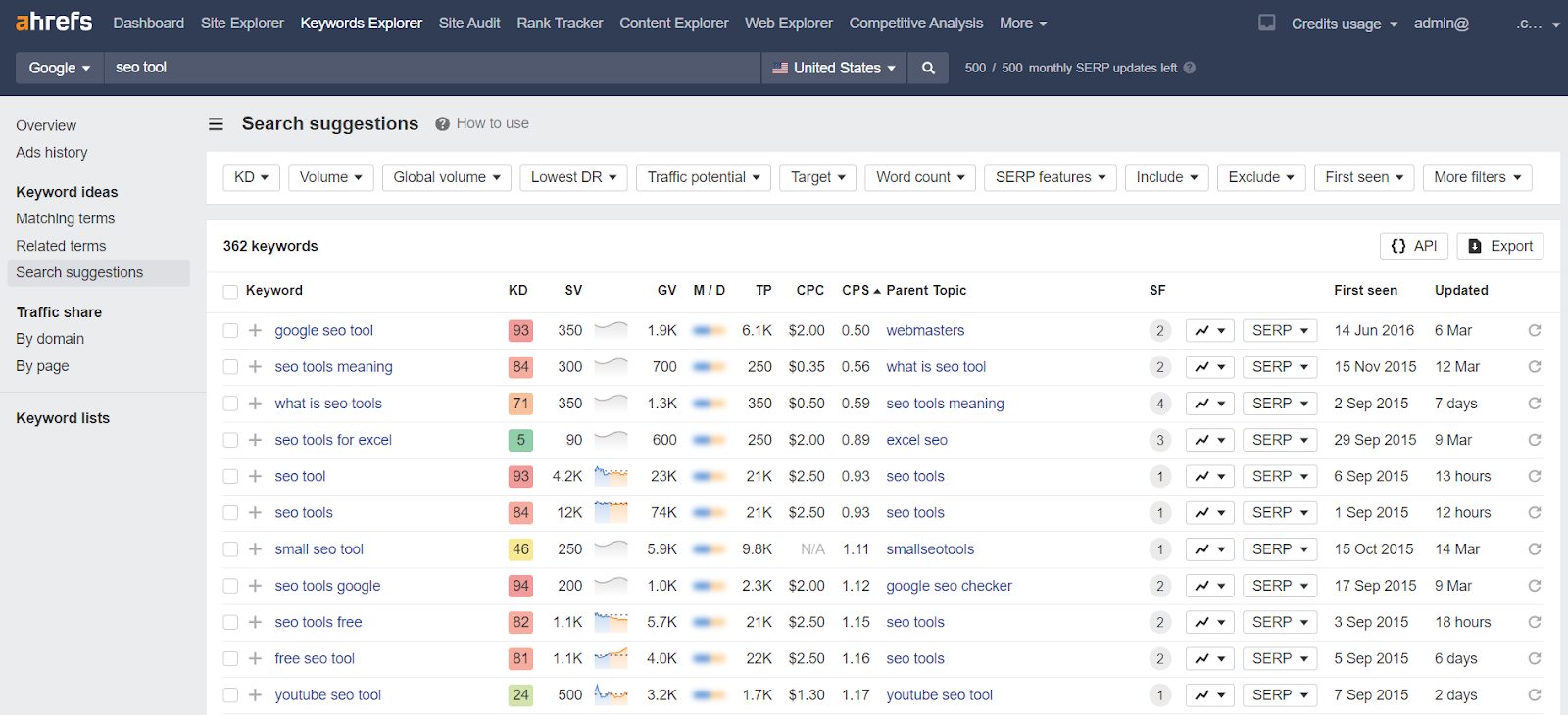
How to Use Google Autocomplete API for Your Keyword Research Tool
We all have that friend who can finish our sentences (or maybe even read our thoughts), don’t we? That’s how to quickly explain the idea behind Google Autocomplete, a very handy tool in search that reduces your typing by up to 25 percent.
Beyond its everyday utility, Google Autocomplete can also help you find great keywords and even enhance your SEO application with useful features. So, how does it work, and how can marketers and developers harness Google Autocomplete SERP API to collect keyword predictions at scale? Let’s dive in!
Contents:
What’s Google Autocomplete and how does it work?
Benefits of using Google Autocomplete data for keyword research
How to collect great keywords at scale with Google Autocomplete API?
Supercharging SEO Tools with Google Autocomplete Data via API
Conclusion
What’s Google Autocomplete and how does it work?
Google Autocomplete is a feature within the Google Search bar that generates queries related to the user’s input in real-time, offering insights into popular topics.

This project was originally called “Google Suggest” and was launched back in 2004. However, now Google defines the completions in the Autocomplete feature as “predictions” and not “suggestions” as you may see in many resources. Google explains why this distinction is important:
“Autocomplete is designed to help people complete a search they were intending to do, not to suggest new types of searches to be performed. These are our best predictions of the query you were likely to continue entering.”
To predict what a user may be going to search for, Google considers several factors:
- The characters entered
- The location from which you are searching
- Query language
- Common and trending topics
- Relevant terms with consistent search volume
- Search history (if the user is logged in to their Google account).
Drawing data from millions of previous Google searches and the content of relevant results, Autocomplete may not always generate the most suitable queries. To combat inappropriate predictions, you can always use the “Report inappropriate predictions” link below the search box on the desktop or long press on a prediction on mobile to request its removal.
Besides your direct influence on what appears in the Autocomplete dropdown, here are a few more things that may change what you get in the results.
First off, Autocomplete results are dynamic meaning that Google goes through all of the factors we listed above every time a user types in a new character, to update the predictions and match the user’s intent.
Besides this, the results may differ depending on the position of the cursor pointer within the keyword entered in the search bar.

The number of Autocomplete results varies depending on the device used for the search. For desktop users, Google typically shows up to ten results in the dropdown, while mobile users get fewer resutls due to the smaller screen size.
Moreover, by accessing Google Search via different web browsers like Google Chrome, Safari, or Firefox, you can also get different predictions. Similarly, Autocomplete results vary across Google web search, Google Shopping search, Google Image search, and YouTube.
Now that you understand all the nuances of Google Autocomplete and how it works, let’s explore the potential of this powerful tool for SEOs and marketers conducting keyword research.
Benefits of using Google Autocomplete data for keyword research
On top of being a practical and time-saving feature for Google users, Autocomplete is also a goldmine of valuable insights into user interests and relevant trending queries. SEOs and digital marketing experts can leverage these insights in combination with other data like keyword metrics from Google Ads, to enhance content creation, improve their advertising strategies, and power up SEO efforts.
Let’s consider a few practical and unique benefits Google Autocomplete data offers for SEO keyword research.
Google Autocomplete is a useful starting point for discovering keywords relevant to your business that you could incorporate into your digital marketing strategies. For example, if you are an owner of a Pilates studio, typing a relevant keyword in Autocomplete will help you get more specific terms your potential customers may use to find your business, such as “pilates near me reformer” or “pilates near me for beginners.”
By playing around with different letters and cursor placements in the search box, you can also explore diverse variations, synonyms, and related terms that you may not have considered previously. In this way, marketers can expand their list of target keywords for advertising purposes and ultimately increase website visibility and audience reach.

The best thing about Google Autocomplete in terms of keyword research is that it extends your query as you type, making it a rich resource for generating long-tail keyword ideas. These longer queries are often more detailed and less competitive, promising more qualified traffic and improving chances for better organic rankings. In par-per-click campaigns, long-tail keywords often yield higher click-through rates (CTR), lower cost-per-click (CPC), and higher conversion rates.
For example, your initial “pilates near me” query can quickly bring you to “pilates reformer classes near me for beginners” and even transform into “how many pilates reformer classes should you do a week” which sounds like a blog post idea.
And this brings us to the next point. Data from the Autocomplete dropdown can be a great source of inspiration for content creation. By identifying popular topics and questions that are relevant to your business, you can generate a list of article concepts and develop more targeted engaging pieces that resonate with your target audience.
In summary, leveraging Google Autocomplete data for keyword research allows marketers and SEO experts to discover valuable long-tail keywords, improve organic and paid strategies, and better tailor their content to the target audience’s needs. As we’ve illustrated with a few simple examples, these benefits are achievable even with a manual approach.
However, what if you manage dozens of websites each with an average keyword list of around 10,000 terms? When it comes to scaling, the keyword generation process with Google Autocomplete becomes increasingly difficult. In the next part, we’ll explore how API can help solve this challenge.
How to collect great keywords at scale with Google Autocomplete API?
Whether you are planning to use Google Autocomplete data for large-scale keyword research or custom software development, you will need to obtain vast data volumes. Doing this by yourself can be tough for several reasons.
First off, scraping keyword predictions directly from the Autocomplete dropdown and ensuring data quality requires substantial technical expertise. You would need to overcome anti-scraping measures employed by Google, handle data quality assurance to avoid errors and duplicates, and address other technical complexities. Second off, building and maintaining a custom system for data collection and processing takes a lot of planning, coding, and costs. Balancing the need for quality data while staying on a budget adds another layer of complexity.
Fortunately, you can rely on ready-made and cost-effective solutions like DataForSEO’s Google Autocomplete API. It allows developers and digital marketing experts to access Autocomplete data programmatically while saving time and effort. Even if you’re not a tech whiz, you will see that this API is a straightforward solution for collecting Autocomplete predictions at scale.
For those new to APIs, our comprehensive article explains what an API is, gives an in-depth overview of how DataForSEO APIs work, and includes all the essential steps for making API calls.
Now, let’s take a quick look at how DataForSEO’s Google Autocomplete SERP API functions. It fetches keyword predictions based on the target query, language, location, cursor_pointer, and client parameters. It’s important to note that DataForSEO’s system ignores user preferences, search history, and other personalized factors to ensure objective results.
If you want to test Google Autocomplete SERP API via a graphic user interface, visit our API Playground.
Below, we will walk you through the process of using DataForSEO’s API to collect Google Autocomplete predictions at scale and will show you how to enrich the obtained keywords with search volume and other essential metrics.
1 Access DataForSEO SERP API
At square one, make sure you understand how to make requests and register to obtain your API credentials (login and password). Also, visit our documentation to download examples for Postman (an easy-to-use API testing tool) or an officially supported client for your programming language.
2 Configure your API call and collect Google Autocomplete data
Define your target keyword and configure additional parameters such as cursor_pointer and client, to refine your Autocomplete result. Later, you can experiment with different values to see how they impact the predictions you receive. Learn more in our docs.
See also: Best practices for handling SERP API requests
Once you collect the predictions that Google offers for your target keyword, you might want to use them as they are, or you might want to add another layer of data on top, such as search volume and competition metrics. To do so, gather all keywords from the suggestion fields of the response and proceed to the next step.
3 Enrich your keywords with more data
DataForSEO offers multiple APIs and endpoints tailored specifically for keyword research. Depending on your needs, you can use Google endpoints of DataForSEO Labs API to obtain keyword difficulty, search intent, and more, or you can explore the possibilities offered in Keyword Data API.
To add search volume, competition, and CPC to your Google Autocomplete keywords, use the Google Ads Search Volume endpoint of Keyword Data API. Similar to step two, configure your API call to the Google Ads Search Volume endpoint specifying the same location and the keywords you received from Google Autocomplete API.
As simple as that, you will obtain valuable data for organizing and prioritizing your keywords.
4 Filter and prioritize
The last step is to filter Google Autocomplete keywords based on search volume, competition, CPC, and other metrics you’ve collected. For example, you can sort your keyword list by search volume to prioritize those with higher traffic potential or refine keywords by competition index to pick less competitive terms to target in your advertising campaigns.
As you can see, DataForSEO’s Google Autocomplete API is an effortless automation solution for finding great keyword opportunities at scale. By combining the keywords you get with valuable keyword metrics from a single reliable provider, you can streamline the entire data integration process, saving time and ensuring consistency. What’s more, our APIs are also cost-efficient as they are offered on a pay-as-you-go basis – check our pricing here.
Armed with the knowledge of accessing Google Autocomplete predictions at scale, let’s explore how this data can be transformed into real-world software features.
Supercharging SEO Tools with Google Autocomplete Data via API
Google Autocomplete data can be a great asset for keyword research and content optimization tools. Below, we’ll showcase some real-life examples of features where you could incorporate the powerful combination of Autocomplete predictions with vital keyword metrics and more.
1 Keyword Tool. The first example in our exploration is a solution where all main functionality heavily relies on Google Autocomplete data. The tool generates long-tail keyword suggestions and works as follows:
“Keyword Tool prepends and appends the search term which you specify with different letters and numbers, places it into Google search box and pulls out keyword suggestions.”
The paid version of the tool also provides search volume, cost-per-click, and competition data from Google Ads for the generated list of keywords. Keyword Tool’s pricing ranges between $89 and $199 per month.
To build a similar solution with DataForSEO APIs, you’ll need to use the combination of DataForSEO Google Autocomplete API and Google Ads Keyword Data API. You can follow the steps we described here to test these products. Here’s a breakdown of the data cost estimation:
➤ Google Autocomplete SERP API: on average, you’ll receive up to 10-15 predictions in response for each target term, so if you make 100,000 API requests, you can obtain around 1 million keyword predictions. If you use the priority queue with a turnaround time of up to 1 minute, obtaining 1 million keyword predictions will cost $120.
➤ Google Ads Keyword Data API: provides up-to-date keyword metrics from Google Keyword Planner for a bulk of up to 1000 keywords in a single API request. The price per 1 million keywords (1,000 tasks with up to 1,000 keywords in each) will be $75 in live mode.
Cost-saving tip: you can use search interest data from Google Trends or DataForSEO Trends API instead of more expensive Google Ads Keyword Data API to show search volume history graphs. These budget-friendly options are often used for lead generation or in tool previews for unregistered users as search volume data and search interest stats make for very close visual representations.
To review detailed pricing information, visit our pricing page or contact us and we will calculate the costs for your expected request volumes.
2 KWFinder tool by Mangools. It provides Autocomplete queries within a dedicated tab and works similarly to the previous solution we’ve reviewed.
Mangools also complements generated keywords with search volume trends, current search volume, CPC, and PPC. What’s different here is that they add keyword difficulty to the mix.
Keyword difficulty is a very handy SEO metric that indicates how difficult it is to rank in search results for a certain keyword and allows users to quickly find high-opportunity keywords with manageable competition. Integrating this metric, KWFinder significantly boosts users’ experience with the tool and enables more informed and efficient keyword research.
In terms of pricing, Mangools’ monthly packages for the KWFinder tool range between $29 and $129 for all keyword research functionality, including the Autocomplete tab.
Leveraging DataForSEO APIs, you can build a powerful keyword research tool similar to KWFinder, offering Google Autocomplete predictions, essential keyword metrics from Google Keyword Planner, as well as keyword difficulty scores, and even more. Here are the API options that will help you enhance users’ keyword research experience:
➤ Google Autocomplete SERP API: $120 for 100,000 API calls with the priority queue delivering, on average, up to 10-15 predictions for each call, so in total, you will obtain around 1 million predictions.
➤ Historical Search Volume endpoint in DataForSEO Labs API: $110 for 1M target keywords with their latest and historical search volume, as well as current CPC, competition, Keyword Difficulty, and other data, including impressions info and the SERP features present in the results.
Visit our documentation for a detailed description of all data points you can get with the Historical Search Volume endpoint of DataForSEO Labs API >>
To learn more about leveraging additional data from the Historical Search Volume endpoint in your tool, keep on reading.
3 Ahrefs’s Keywords Explorer. In our final noteworthy example, you can find Google Autocomplete queries in a dedicated “Search Suggestions” report.
Besides search volume and CPC for suggested terms, the report includes Ahrefs’s proprietary metrics such as keyword difficulty, global search volume, mobile/desktop distribution, traffic potential, and clicks per search. In addition to these valuable metrics, the “Search Suggestions” section of Keywords Explorer offers a bunch of practical features allowing to conduct more exhaustive research.
Let’s explore some of these additional features in more detail and how to build them with DataForSEO’s APIs.
➤ Parent topic: helps users to identify a broader topic to target in addition to the suggested term. Ahrefs determines the Parent topic by analyzing the top-ranking page for the suggested term and finding the keyword sending the most traffic to that page.
To add this feature, you should collect the terms generated with Google Autocomplete SERP API, and specify them as target keywords when making calls to the Historical Search Volume endpoint of DataForSEO Labs API. Then, use the core_keyword string of the response, it will indicate the main keyword in a group determined by our synonym clustering algorithm.
➤ SERP features: provides the list of rich snippets and other non-organic search results that appear in SERP for the suggested term. Depending on the user’s goals, they can use this information in various ways, for example: to understand what type of content (videos, images, etc) may fit search intent better, or to filter the results for specific SERP features and identify keywords that may help them win a featured snippet, knowledge panel, people also ask box, etc.
To display this data, modify the body of your requests to the Historical Search Volume endpoint of DataForSEO Labs API beforehand by adding the include_serp_info parameter set to true. Once you do this, the API response will contain a serp_info object where you find serp_item_types listing all types of search results (items) found in the SERP for the related keyword.
As you can see, keyword research tools like Keyword Tool, KWFinder by Mangools, and Ahrefs’s Keywords Explorer transform Autocomplete predictions and up-to-date keyword metrics into multiple useful features. Leveraging DataForSEO APIs, you can replicate Autocomplete-based functionality from these tools and build more robust alternatives in a streamlined and cost-effective way.
Conclusion
In conclusion, Google Autocomplete data offers tons of benefits for data enthusiasts and keyword research software developers alike. Digital marketers and SEOs can use it to gain insights into trending topics, generate long-tail keywords, and enhance advertising strategies. Developers can utilize Autocomplete predictions in combination with essential keyword metrics to create powerful tools with advanced keyword analysis features.
To streamline the process of collecting Google Autocomplete data at scale, you can rely on DataForSEO’s Google Autocomplete SERP API. It eliminates the need for mastering complex scraping techniques and manual data processing.
What’s more, DataForSEO offers robust solutions for complementing Google Autocomplete data with valuable SEO metrics, such as Google Ads and Google Trends Keyword Data APIs, DataForSEO Trends API, and Historical Search Volume endpoint of DataForSEO Labs API.
Best of all, with DataForSEO, you will get affordable APIs on a pay-as-you-go basis, minimizing data costs while increasing the efficiency of your work.
Register for a free trial today and test Google Autocomplete SERP API in our API Playground!



